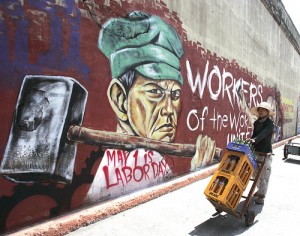THE Philippines marks Labor Day today as millions of Filipinos struggle to survive because the Aquino government has failed to create enough jobs to lower the unemployment rate, former senator Ernesto Herrera, the president of the Trade Union Congress of the Philippines (TUCP), said.
Herrera noted that President Benigno Aquino 3rd has been in his post four years and yet the number of unemployed people continues to rise.
“When the President began his term, the official national unemployment rate was 7.0 percent in July 2010. Now, the unemployment rate stands at 7.5 percent, as of January 2014,” he said.
“We are deeply disappointed that up to now, the administration has not offered, not even in broad strokes, clear-cut strategies as to how it intends to forcefully create new jobs,” the former chairman of the Senate committee on labor, employment and human resources development added.
According to the Philippine Statistics Authority, as of January 2014, 10.07 million able-bodied Filipinos were either totally jobless (2.969 million unemployed) or had little work and were desperately looking for additional work and income (7.101 million underemployed).
A separate survey by the Social Weather Stations showed that 12.1 million Filipinos were completely without work in the last quarter of 2013, implying a much higher jobless rate of 27.5 percent.
In a news conference on the eve of Labor Day, Herrera said the government has to create three million to four million jobs every year to bridge the unemployment gap.
He also noted that around 48 percent of people without jobs are in the 14 to 27 age bracket, and these are mostly educated and skilled. Herrera was joined by former Labor Secretary Ruben Torres of the BPO Workers’ Association of the Philippines (BWAP), TUCP vice president and former Agriculture Secretary Leonardo Montemayor of the Federation of Free Farmers (FFF), and TUCP secretary-general Jose Umali Jr. of the National Union of Bank Employees (NUBE).
To lower the unemployment rate, the government must create highly labor-intensive factories and provide livelihood to returning overseas workers who could be the backbone of the small and informal businesses, he said.
“We need sound, aggressive and actionable strategies to propel jobs growth in an orderly manner and remove hurdles to full employment. We also need extra ‘fast-break’ measures to create new jobs for marginal households,” Herrera added.
These “fast-break” measures could include tapping all available assets, including idle or non-performing government land for public housing and other labor-intensive projects and community employment programs tied to infrastructure projects.
“Jobs provide people with incomes that enable them to buy goods and services or to save. The increase in consumption stimulates the market, builds up the economy and provides additional revenue for government. And the accumulation of savings provides more funds for investment,” Herrera said.
He proposed a national employment plan that will compel all government agencies and state-owned firm to carry out more labor-intensive projects.
“Let us ensure that every public project and that every private sector endeavor is highly labor-intensive. Let us compel every agency to set achievable employment targets. Then let us assign an inter-agency panel to monitor performance in terms of jobs creation,” the TUCP president said.
As to the private sector, Herrera added, loan applications with government financial institutions should be approved on the basis of the number of jobs the projects to be funded would create.
The government would also need to focus on public works that have the highest job-creation potential and generate the highest returns. These projects, such as farm-to-market roads, school buildings and irrigation systems, are also urgently needed, he said.
Whether such projects involve new construction or maintenance, they provide direct employment, help lower cost of production and, consequently, reduce the prices of goods, according to the former senator.
No wage hike
Meanwhile, the Department of Labor and Employment (DOLE) sees no reason for a wage increase.
Labor Secretary Rosalinda Baldoz explained that they have to wait for the wage order anniversary or some “supervening events” before entertaining petitions for a wage increase.
The DOLE can act on petitions for wage increase in a particular region only once a year.
“As far as the National Capital Region (Metro Manila) is concerned, their wage anniversary is January, which was the date for the effectivity of the second tranche of the wage order,” Baldoz said.
“It is also stated in the law that unless there is a supervening event or the extraordinary increase in the prices of basic commodities then the regional tripartite wage board would not entertain a wage increase,” she added.
But, Bishop Broderick Pabillo, auxiliary bishop of the Archdiocese of Manila and chairman of the Episcopal Commission on Social Action, Justice and Peace of the Catholic Bishops’ Conference of the Philippines (CBCP), said the government should have a gift to workers on Labor Day such as better working conditions or additional pay.
Pabillo added that the government had been trumpeting the country’s high economic growth but this has not been felt by ordinary Filipinos.
“The growth is not inclusive. Where is that growth? It is only felt on top, it doesn’t trickle down,” he said.
With Robertzon F. Ramirez


